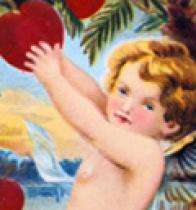Probing Question: How did Valentine's Day start?

Never mind the 160 million greeting cards that will be purchased for Valentine's Day this year. Forget about the 35 million heart-shaped boxes of chocolates that will pass from giver to recipient. Long before today's modern commercialized frenzy, Valentine's Day was, well, just another day to commemorate a saint. In Catholic tradition practically every day of the year is a saint's day, so how did Saint Valentine -- instead of, say, Saint Sigfrid, whose day is Feb. 15 -- become associated with romantic love?
"The earliest evidence of an association between Saint Valentine's Day and celebrating romantic love is in a 14th-century poem by Chaucer," said Caroline Eckhardt, head of Penn State's Department of Comparative Literature. "The title of the poem is the 'Parliament of Fowls,' and the events described in it occur on St. Valentine's Day. The poem tells a story about birds who come to an assemblage or parliament to choose their mates." Most of the birds, who speak as if they were human, find partners, but the leading female bird is desired by three male suitors, and the poem ends with a year's postponement in deciding the outcome of this romantic quadrangle.
Which suitor's yearnings will be satisfied is not the only puzzle in this poem, which mentions Valentine's Day with almost no explanation. "By the late 14th century, when Chaucer was writing, his audience in England must have recognized the connection between St. Valentine's day and romantic love and sexuality," Eckhardt points out. Otherwise, Chaucer would have needed to explain it more fully in the poem." Thus he was probably not the originator of this tradition. Yet no earlier texts have yet been found that mention St. Valentine's Day as an occasion to celebrate romantic love.
Not only that, the date on which we now celebrate St. Valentine's Day may not be the one Chaucer meant. "His poem does not represent a mid-February setting," Eckhardt said. "Instead, it depicts a springtime scene. The narrator sees a garden full of blossoms -- white, blue, yellow and red flowers -- there are small fish in the stream, and there is a lot of birdsong." The season could be as late as May.
"The leading female bird and her suitors are very aristocratic, and some scholars, looking for a historical allegory, have tried to identify these characters -- suggesting, for example, that one of these male birds represents England's King Richard II and the female bird is Anne of Bohemia," Eckhardt said. "Richard became engaged to Anne around the era of this poem, and one of the treaties for their marriage was signed in May, 1381." This could explain the springtime setting. Still, why the connection to Saint Valentine and, for us, February?
"There are multiple Saint Valentines, but none of them seems a good fit for this romantic holiday," Eckhardt said. Among Valentines with February saints' days, "Saint Valentine of Rome was a priest martyred in the third century. Another Valentine became bishop of Terni; little is known about a third, who was also martyred. None of their biographies has a romantic focus. Their life stories each describe the life of a man named Valentine who was devoted to the Christian religion and died for it." A different Saint Valentine has his own day in May but his story too lacks a love interest.
Eckhardt points out what she considers an even bigger mystery. "What interests me is why certain medieval literary and cultural traditions are durable across times and places, while others fade away and are lost. I don't have an answer to why this one not only survived but became distributed worldwide." Indeed, Valentine's Day has expanded almost exponentially, from poetry in medieval England to the Victorian-era obsession over lace and ribbon cards, to a twenty-first century holiday celebrated in places as far-flung as Singapore, Guatemala, and South Africa.
Provided by Pennsylvania State University


















